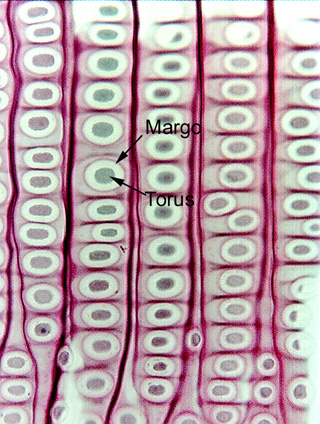Up
Primary xylem
Oak wood
Leaf vein
Vein ends
Bean seed
Pine tracheids, xs
Fern TE, xs
Fern, TE, mag
Annular walls
Annular, stretched
Annular, narrow
Scalariform walls
Scalar., narrow
CBP, pine
CBP, dicot
CBP, irregular
Contact faces
Pits, side view
CBP, pine, xs
CBP,angio, xs
CBP, fern, xs
Contact face, xs
Simple perf. plate 1
Simple perf. plate 2
Pitted perf. plate
Perf. plate & helix
Perf. plate, face
Perf. plate, mag
Perf. plate, section
Perf. plate rim
Perf. plate & wall
Scalariform Per plate
Primary xylem
Vessel sizes
Fern TE
Pine needle
VE precursor, ls
Protoxylem
9 Contact faces
VE precursor, xs
Precursor 2
Torn vessel
Torn vessel 2
| |
 Fig.
7-2-6. Longitudinal section of pine wood (Pinus). All cells
shown here are tracheids, and all the circular structures are circular bordered pits. The outer white
area is known as the margo, the inner dark area is the torus. The margo is an
area where the pit membrane is very thin, partially digested away in some
species such that water passes relatively easily through it. The torus, in
contrast, is a thickened area that can seal off the pit if one of the tracheids
becomes filled with air. Compare this with Fig. 7.13 on page 117 in Plant
Anatomy (Mauseth). Fig.
7-2-6. Longitudinal section of pine wood (Pinus). All cells
shown here are tracheids, and all the circular structures are circular bordered pits. The outer white
area is known as the margo, the inner dark area is the torus. The margo is an
area where the pit membrane is very thin, partially digested away in some
species such that water passes relatively easily through it. The torus, in
contrast, is a thickened area that can seal off the pit if one of the tracheids
becomes filled with air. Compare this with Fig. 7.13 on page 117 in Plant
Anatomy (Mauseth).
These circular bordered pits are especially large – that is why pine
wood is a favorite material in all Plant Anatomy Laboratories. In dicots, many
tracheary elements have circular bordered pit, but they are much smaller.
|
 Fig.
7-2-6. Longitudinal section of pine wood (Pinus). All cells
shown here are tracheids, and all the circular structures are circular bordered pits. The outer white
area is known as the margo, the inner dark area is the torus. The margo is an
area where the pit membrane is very thin, partially digested away in some
species such that water passes relatively easily through it. The torus, in
contrast, is a thickened area that can seal off the pit if one of the tracheids
becomes filled with air. Compare this with Fig. 7.13 on page 117 in Plant
Anatomy (Mauseth).
Fig.
7-2-6. Longitudinal section of pine wood (Pinus). All cells
shown here are tracheids, and all the circular structures are circular bordered pits. The outer white
area is known as the margo, the inner dark area is the torus. The margo is an
area where the pit membrane is very thin, partially digested away in some
species such that water passes relatively easily through it. The torus, in
contrast, is a thickened area that can seal off the pit if one of the tracheids
becomes filled with air. Compare this with Fig. 7.13 on page 117 in Plant
Anatomy (Mauseth).